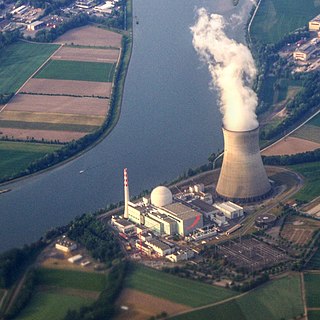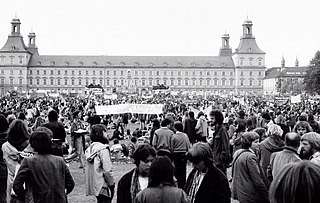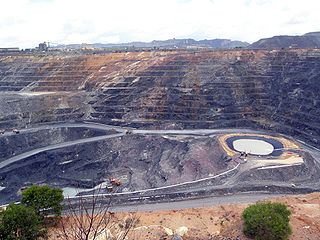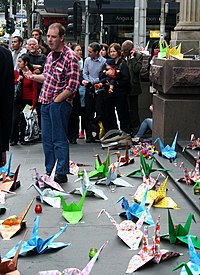
Nuclear power is the use of nuclear reactions to produce electricity. Nuclear power can be obtained from nuclear fission, nuclear decay and nuclear fusion reactions. Presently, the vast majority of electricity from nuclear power is produced by nuclear fission of uranium and plutonium in nuclear power plants. Nuclear decay processes are used in niche applications such as radioisotope thermoelectric generators in some space probes such as Voyager 2. Generating electricity from fusion power remains the focus of international research.

The United States Atomic Energy Commission (AEC) was an agency of the United States government established after World War II by the U.S. Congress to foster and control the peacetime development of atomic science and technology. President Harry S. Truman signed the McMahon/Atomic Energy Act on August 1, 1946, transferring the control of atomic energy from military to civilian hands, effective on January 1, 1947. This shift gave the members of the AEC complete control of the plants, laboratories, equipment, and personnel assembled during the war to produce the atomic bomb.

Nuclear technology is technology that involves the nuclear reactions of atomic nuclei. Among the notable nuclear technologies are nuclear reactors, nuclear medicine and nuclear weapons. It is also used, among other things, in smoke detectors and gun sights.

Lucas Heights is a suburb in southern Sydney, in the state of New South Wales, Australia. It is near to the Royal National Park.

The High Flux Australian Reactor (HIFAR) was Australia's first nuclear reactor. It was built at the Australian Atomic Energy Commission Research Establishment at Lucas Heights, Sydney. The reactor was in operation between 1958 and 2007, when it was superseded by the Open-pool Australian lightwater reactor, also in Lucas Heights.

The Open-pool Australian lightwater reactor (OPAL) is a 20 megawatt (MW) swimming pool nuclear research reactor. Officially opened in April 2007, it replaced the High Flux Australian Reactor as Australia's only nuclear reactor, and is located at the Australian Nuclear Science and Technology Organisation (ANSTO) Research Establishment in Lucas Heights, New South Wales, a suburb of Sydney. Both OPAL and its predecessor have been commonly known simply as the Lucas Heights reactor.

The Bhabha Atomic Research Centre (BARC) is India's premier nuclear research facility, headquartered in Trombay, Mumbai, Maharashtra, India. It was founded by Homi Jehangir Bhabha as the Atomic Energy Establishment, Trombay (AEET) in January 1954 as a multidisciplinary research program essential for India's nuclear program. It operates under the Department of Atomic Energy (DAE), which is directly overseen by the Prime Minister of India.

The anti-nuclear movement is a social movement that opposes various nuclear technologies. Some direct action groups, environmental movements, and professional organisations have identified themselves with the movement at the local, national, or international level. Major anti-nuclear groups include Campaign for Nuclear Disarmament, Friends of the Earth, Greenpeace, International Physicians for the Prevention of Nuclear War, Peace Action, Seneca Women's Encampment for a Future of Peace and Justice and the Nuclear Information and Resource Service. The initial objective of the movement was nuclear disarmament, though since the late 1960s opposition has included the use of nuclear power. Many anti-nuclear groups oppose both nuclear power and nuclear weapons. The formation of green parties in the 1970s and 1980s was often a direct result of anti-nuclear politics.

Mark Diesendorf is an Australian academic and environmentalist, known for his work in sustainable development and renewable energy. He currently teaches environmental studies at the University of New South Wales, Australia. He was formerly professor of environmental science and founding director of the Institute for Sustainable Futures at the University of Technology, Sydney and before that a principal research scientist with CSIRO, where he was involved in early research on integrating wind power into electricity grids. His most recent book is Sustainable Energy Solutions for Climate Change.
Nuclear power is the fifth-largest source of electricity in India after coal, gas, hydroelectricity and wind power. As of November 2020, India has 22 nuclear reactors in operation in 8 nuclear power plants, with a total installed capacity of 7,380 MW. Nuclear power produced a total of 43 TWh in 2020–21, contributing 3.11% of total power generation in India. 10 more reactors are under construction with a combined generation capacity of 8,000 MW.

The anti-nuclear movement in the United States consists of more than 80 anti-nuclear groups that oppose nuclear power, nuclear weapons, and/or uranium mining. These have included the Abalone Alliance, Clamshell Alliance, Committee for Nuclear Responsibility, Nevada Desert Experience, Nuclear Information and Resource Service, Physicians for Social Responsibility, Plowshares Movement, Women Strike for Peace, Nukewatch, and Women's International League for Peace and Freedom. Some fringe aspects of the anti-nuclear movement have delayed construction or halted commitments to build some new nuclear plants, and have pressured the Nuclear Regulatory Commission to enforce and strengthen the safety regulations for nuclear power plants. Most groups in the movement focus on nuclear weapons.

Nuclear power has various environmental impacts, both positive and negative, including the construction and operation of the plant, the nuclear fuel cycle, and the effects of nuclear accidents. Nuclear power plants do not burn fossil fuels and so do not directly emit carbon dioxide. The carbon dioxide emitted during mining, enrichment, fabrication and transport of fuel is small when compared with the carbon dioxide emitted by fossil fuels of similar energy yield, however, these plants still produce other environmentally damaging wastes. Nuclear energy and renewable energy have reduced environmental costs by decreasing CO2 emissions resulting from energy consumption.

Nuclear weapons testing, uranium mining and export, and nuclear power have often been the subject of public debate in Australia, and the anti-nuclear movement in Australia has a long history. Its origins date back to the 1972–1973 debate over French nuclear testing in the Pacific and the 1976–1977 debate about uranium mining in Australia.
Jim Falk is a physicist and academic researcher on science and technology studies.

The prospect of nuclear power in Australia has been a topic of public debate since the 1950s. Australia has one nuclear plant in Lucas Heights, Sydney, but is not used to produce nuclear power, but instead is used to produce medical radioisotopes. It also produces material or carries out analyses for the mining industry, for forensic purposes and for research. Australia hosts 33% of the world's uranium deposits and is the world's third largest producer of uranium after Kazakhstan and Canada.

The nuclear power debate is a long-running controversy about the risks and benefits of using nuclear reactors to generate electricity for civilian purposes. The debate about nuclear power peaked during the 1970s and 1980s, as more and more reactors were built and came online, and "reached an intensity unprecedented in the history of technology controversies" in some countries. In the 2010s, with growing public awareness about climate change and the critical role that carbon dioxide and methane emissions plays in causing the heating of the earth's atmosphere, there was a resurgence in the intensity of the nuclear power debate.

Radioactive ores were first extracted in South Australia at Radium Hill in 1906 and Mount Painter in 1911. 2,000 tons of ore were treated to recover radium for medical use. Several hundred kilograms of uranium were also produced for use in ceramic glazes.
The following outline is provided as an overview of and topical guide to nuclear power:

The Nuclear Fuel Cycle Royal Commission is a Royal Commission into South Australia's future role in the nuclear fuel cycle. It commenced on 19 March 2015 and delivered its final report to the Government of South Australia on 6 May 2016. The Commissioner was former Governor of South Australia, Kevin Scarce, a retired Royal Australian Navy Rear-Admiral and chancellor of the University of Adelaide. The Commission concluded that nuclear power was unlikely to be economically feasible in Australia for the foreseeable future. However, it identified an economic opportunity in the establishment of a deep geological storage facility and the receipt of spent nuclear fuel from prospective international clients.

















